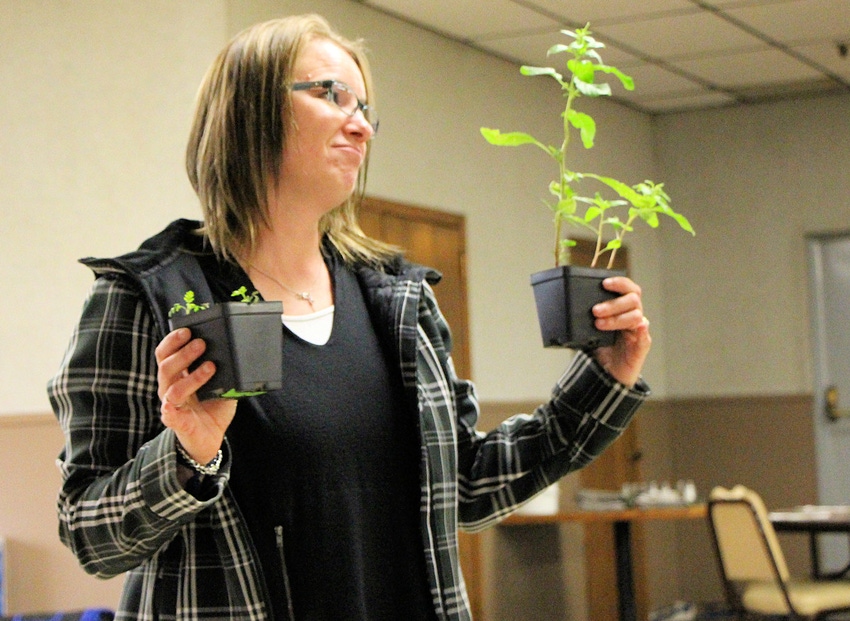April 20, 2016

Note: This is the third in a series on fine-tuning your spraying, this time with a look at ways to improve your approach to beat tough weeds.
Don't miss other parts of the series:
7 products you shouldn't go without at spray time
Video Demo: Picking the right spray nozzle
Mark Glady, regional agronomist with Winfield, puts on 50,000 miles a year looking at fields in his territory of west central Minnesota. He says the biggest problem he sees on the road is lack of control of waterhemp in soybeans.
“It’s pretty much what everyone wants to talk about,” Glady says. “They are much less concerned about killing weeds in corn. They want to know, “How can I kill waterehemp in my soybeans, and how do I kill them without burning my beans,” Glady says.
He says killing tough weeds such as waterhemp is harder in soybeans than it is in corn because soybeans and weeds are both broadleaf crops with similar physiological pathways, which makes it difficult to find herbicides that have activity on the broadleaf weed but not the broadleaf crop. Corn, on the other hand, is a grass crop, which has different physiological pathways than broadleaf weeds, so it’s easier to find herbicides that select for broadleaves but not grasses.
With fewer product options for soybeans, management becomes all the more important. In walking the fields, Glady sees the same mistakes being made. Here are three of the most common ones and how to avoid them.
1. Using the same nozzle to apply all products
Different herbicides, fungicides, and insecticides require different degrees of coverage to be effective. You can partially adjust for those differences with proper nozzle selection. Glady devotes most of his time at sprayer clinics to show growers which nozzles to select for different jobs. [See his nozzle demo “here” as part of our Sprayer Tech series.] He boils down the decision to three different nozzle types—a flat fan nozzle that produces small droplets, an air induction extended range nozzle that produces medium droplets and an air induction nozzle that produces large droplets - check out Know your spray nozzle vocabulary to learn more about nozzle types. And see Glady in a video demo showing how the three nozzle types work.
2. Not spraying enough gallons
When applying post-emergent contact herbicides to control weeds in-season in soybeans, the minimum recommend rate is 15 gallons per acre, Glady says. “A lot of growers like to spray 15 gallons, which is the absolute low end on most herbicide labels,” Glady says. “You can kill weeds at 15 gallons if they are small and if the wind isn’t blowing away some of the chemical. But 20 gallons gives you better coverage and a better chance of killing the weeds, especially tough ones like waterhemp.”
3. Spraying weeds taller than 4 inches
When weeds get that high, they are extremely hard to kill, especially if the weed is waterhemp, Glady says. “When they get taller than a pop can, they will start sucking a significant amount of water and nutrients away from the soybean crop, and you will see substantial yield loss,” he says.
“Some farmers will say they want to wait another week to spray to make sure all the weeds are up,” Glady continues. “But if you have glyphosate-resistant waterhemp, it is extremely difficult to kill in post-emergent soybeans when the waterhemp gets to be 4 to 5 inches tall.”
“But when waterhemp can grow three-quarter inches in one day, if you wait for the small ones to come up you will lose the chance of killing the big ones that are already there.
For that reason, Glady recommends using an in-season residual herbicide so that you are not relying solely on post-emergent control. “When waterhemp can grow three-quarter inches in one day, it is hard to kill in a field and spray with the wind blowing,” Glady says. “So you need other strategies such as partnering an in-season residual herbicide with your early season post application to get the small emerged weeds and to get the waterhemp that still is waiting to come out of the ground. Then you don’t have to worry about waiting that extra week for all the weeds to emerge.”
About the Author(s)
You May Also Like




